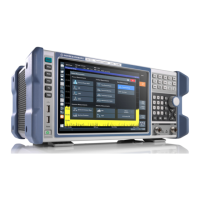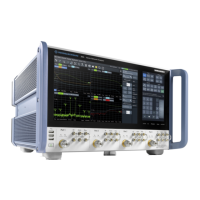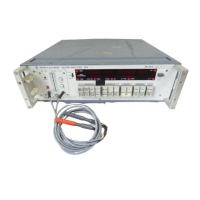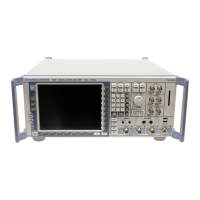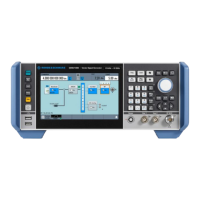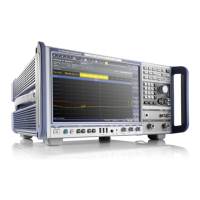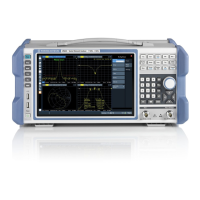
Do you have a question about the Rohde & Schwarz R&S FSH Series and is the answer not in the manual?
| Brand | Rohde & Schwarz |
|---|---|
| Model | R&S FSH Series |
| Category | Measuring Instruments |
| Language | English |
Diagram and labels of the R&S FSH front panel for spectrum mode measurements.
Instructions for unpacking the R&S FSH and its accessories from the packaging.
Guidance on positioning the R&S FSH for desktop use or for service applications.
Steps to power the R&S FSH using the power supply unit or internal battery.
Description and specifications for RF input, trigger, power supply, and headphone connectors.
Details on connecting the R&S FSH to a printer or PC using an optical interface.
Information on the connector for powering and data transfer with R&S power sensors.
Specifications for connecting the tracking generator output to a DUT.
Adjusting screen brightness, contrast, and color settings for optimal display.
Configuring language, date format, and unit of length for country-specific needs.
Procedure for setting the internal clock's date and time for data logging.
Instructions for charging the R&S FSH's nickel metal hydride battery.
Setting the R&S FSH to factory default or custom preset configurations.
Configuring the BNC connector for external trigger or reference signal input.
Basic operation for measuring level and frequency of sinewave signals.
Adjusting the reference level for optimal dynamic range in spectrum analysis.
Using the frequency counter for accurate marker frequency readouts.
Measuring harmonic levels and ratios using marker functions.
Connecting and operating R&S FSH power sensors for accurate power measurements.
Using directional power sensors for measuring forward/reflected power and load matching.
Measuring gain or attenuation of two-port devices using the tracking generator.
Performing reflection measurements using VSWR bridges and calibration.
Locating cable faults and determining their distance using the DTF measurement function.
Checking spectrum and reflections for interfering signals and antenna matching.
Measuring signal levels at specific frequencies using the receiver mode (option R&S FSH-K3).
Measuring the ratio of carrier power to noise power using dedicated function.
Overview of the spectrum analyzer display elements in spectrum mode without markers.
Display elements and softkey status indication when using markers.
Methods for entering values, units, and text using the keypad and rotary knob.
Using unit keys to specify units like GHz, dBm, V, s, or kHz.
Diagrams illustrating the menu structure for Frequency, Span, Level, and Bandwidth settings.
Menu structure for Sweep time, Sweep mode, and Trigger settings.
Options for Trace mode (Clear/Write, Average, Max Hold, Min Hold, View) and Detector selection.
Functions for controlling markers, automatic positioning, and marker lists.
Adding and adjusting a horizontal display line for signal level determination.
Setting the R&S FSH to its default configuration using the PRESET key.
Viewing and printing current measurement parameter settings on the screen.
Entering center, start, and stop frequencies, including offsets and channel tables.
Adjusting the frequency range displayed on the screen for measurements.
Configuring reference level, display range, units, offset, and input impedance.
Selecting resolution and video bandwidths for signal analysis.
Configuring sweep time, sweep mode (continuous/single), and trigger functions.
Managing trace modes, detectors, and trace memory for signal display.
Functions for marker positioning, automatic placement, and multimarker analysis.
Adjusting a horizontal line on the display for signal level reference.
Overview of measurement functions like channel power and TDMA power.
Measuring signal power within a specific transmission channel.
Measuring power of TDMA signals, including setting standards and trigger.
Measuring the bandwidth containing a specified percentage of transmitter power.
Calculating the ratio of carrier power to noise power for signal quality analysis.
Operating the R&S FSH as a receiver to measure levels at specific frequencies.
Connecting and using R&S FSH power sensors for accurate power measurements.
Using directional power sensors to measure forward and reflected power.
Performing transmission and reflection measurements using the tracking generator.
Calculating cable loss using return loss measurements with DTF option.
Determining cable characteristics, locating faults, and selecting cable models.
Setting and monitoring upper and lower limits for signal characteristics.
Applying transducer factors for accurate measurements with antennas and other devices.
Measuring resultant field strength using an isotropic antenna and R&S FSH.
Saving, loading, and deleting instrument settings and measurement data sets.
Printing screenshots of the R&S FSH display to a connected printer.
Fundamental principles of spectrum analyzer operation and measurement techniques.

